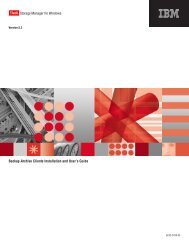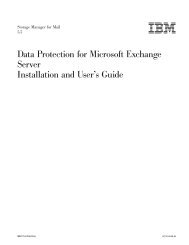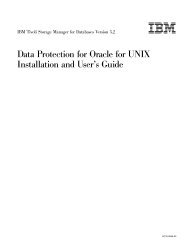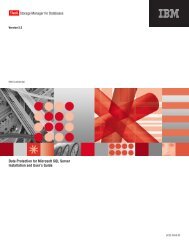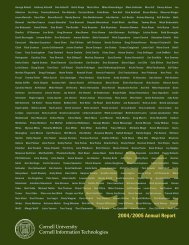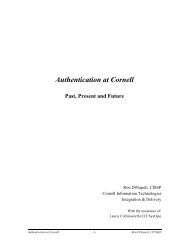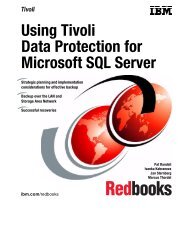Backing Up Oracle - Computing at Cornell
Backing Up Oracle - Computing at Cornell
Backing Up Oracle - Computing at Cornell
You also want an ePaper? Increase the reach of your titles
YUMPU automatically turns print PDFs into web optimized ePapers that Google loves.
10.1.1.1 RMAN command<br />
The RMAN command is the administr<strong>at</strong>or's interface to RMAN. It invokes a<br />
command line interface th<strong>at</strong> provides an oper<strong>at</strong>ing system independent<br />
scripting language for performing backup and recovery oper<strong>at</strong>ions. RMAN<br />
can be executed either interactively, where a command prompt is displayed<br />
and additional RMAN commands entered, or in b<strong>at</strong>ch mode, where an RMAN<br />
script containing commands is executed.<br />
10.1.1.2 Target d<strong>at</strong>abase<br />
The target d<strong>at</strong>abase is the <strong>Oracle</strong>8 d<strong>at</strong>abase instance on which RMAN<br />
executes specified backup, restore, and recovery actions. When the RMAN<br />
command is executed, it connects to the target d<strong>at</strong>abase. The target<br />
d<strong>at</strong>abase is specified by using RMAN parameters.<br />
10.1.1.3 Communic<strong>at</strong>ion channel<br />
RMAN can perform backup and restore functions to either local disk or to<br />
external media management products such as an TSM server through the<br />
orasbt.dll library provided by TDP for <strong>Oracle</strong> for Windows. These I/O<br />
oper<strong>at</strong>ions are performed over a communic<strong>at</strong>ion channel th<strong>at</strong> defines the<br />
device to be used for the oper<strong>at</strong>ion. The channel is used by RMAN to send or<br />
receive backup d<strong>at</strong>a to and from the I/O device.<br />
For backup and restore oper<strong>at</strong>ions, you must alloc<strong>at</strong>e a channel before the<br />
oper<strong>at</strong>ion is performed. A channel corresponds to a single device. With the<br />
TDP for <strong>Oracle</strong> for Windows, a channel is a single session to an TSM server.<br />
Multiple channels can be alloc<strong>at</strong>ed. RMAN provides a multiplexing fe<strong>at</strong>ure<br />
th<strong>at</strong> enables parallel d<strong>at</strong>a streams to be sent over multiple alloc<strong>at</strong>ed channels<br />
to maximize backup and recovery performance.<br />
10.1.1.4 Recovery c<strong>at</strong>alog<br />
The recovery c<strong>at</strong>alog is the repository for inform<strong>at</strong>ion about backup objects<br />
cre<strong>at</strong>ed by RMAN. It is a <strong>Oracle</strong>8 d<strong>at</strong>abase instance, separ<strong>at</strong>e from the target<br />
d<strong>at</strong>abases, and can contain inform<strong>at</strong>ion for multiple target d<strong>at</strong>abases. The<br />
d<strong>at</strong>a stored in the recovery c<strong>at</strong>alog comprises structural inform<strong>at</strong>ion about the<br />
target d<strong>at</strong>abases to back up and restore. The recovery c<strong>at</strong>alog contains<br />
inform<strong>at</strong>ion about:<br />
Physical schema of a target d<strong>at</strong>abase<br />
You have to register the target d<strong>at</strong>abase <strong>at</strong> the recovery c<strong>at</strong>alog to define<br />
the physical schema of the target d<strong>at</strong>abase. RMAN needs to know about<br />
any structural change of the target d<strong>at</strong>abase and obtains this inform<strong>at</strong>ion<br />
from the target d<strong>at</strong>abase control file.<br />
154 <strong>Backing</strong> <strong>Up</strong> <strong>Oracle</strong> using Tivoli Storage Management



